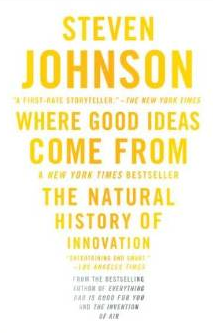I recently read “Where Good Ideas Come From: The Natural History of Innovation” by Steven Johnson. Below are the quotes I found most interesting. As always, if you like the quotes, please buy the book here.
 “Good ideas are inevitably constrained by the parts and skills that surround them.” (28)
“Good ideas are inevitably constrained by the parts and skills that surround them.” (28)
“The history of cultural progress is, almost without exception, a story of one door leading to another door, exploring the palace one room at a time.” (36)
“The most productive tool for generating good ideas remains a circle of humans at a table, talking shop.” (61)
“Most great ideas come into the world half-baked, more hunch than revelation.” (75)
“Most great ideas first take shape in a partial, incomplete form. They have the seeds of something profound, but they lack a key element that can turn the hunch into something truly powerful. And more often than not, that missing element is somewhere else, living as another hunch in another person’s head. Liquid networks create an environment where those partial ideas can connect; they provide a kind of dating service for promising hunches. They make it easier to disseminate good ideas, of course, but they also do something more sublime: they help complete ideas.” (75)
“The secret to organizational inspiration is to build information networks that allow hunches to persist and disperse and recombine.” (127)
“The groups that had been deliberately contaminated with erroneous information ended up making more original connections than the groups that had only been given pure information.” (141)
“An important part of Gutenberg’s genius, then, lay not in conceiving an entirely new technology from scratch, but instead from borrowing a mature technology from an entirely different field, and putting it to work to solve an unrelated problem.” (153)
“Lifestyles or interests that deviate from the mainstream need critical mass to survive; they atrophy in smaller communities not because those communities are more repressive, but rather because the odds of finding like-minded people are much lower with a smaller pool of individuals.” (160)
“But encouragement does not necessarily lead to creativity. Collisions do – the collisions that happen when different fields of expertise converge in some shared physical or intellectual space. That’s where the true sparks fly.” (163)
“Diverse, horizontal social networks, in Ruef’s analysis, were three times more innovative than uniform, vertical networks. In groups united by shared values and long-term familiarity, conformity and convention tended to dampen any potential creative sparks.” (166)
“The entrepreneurs who built bridges outside their “islands,” as Ruef called them, were able to borrow or co-opt new ideas from these external environments and put them to use in a new context.” (166)
“Watson and Crick were notorious for taking long, rambling coffee breaks, where they tossed around ideas in a more playful setting outside the lab – a practice that was generally scorned by their more fastidious colleagues.” (169)
“Genres supply a set of implicit rules that have enough coherence that traditionalists can safely play inside them, and more adventurous artists can confound our expectations by playing with them.” (191)
“When you don’t have to ask for permission, innovation thrives.” (209)
“Every twenty-five to thirty years a new batch of genres becomes dominant, as a new generation of readers seeks out new literary conventions.” (224)
Liked the quotes? Click here to buy the book.

